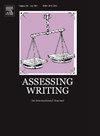青年英语学习者写作中的词汇丰富性:对观点和听写任务类型的关注
IF 5.5
1区 文学
Q1 EDUCATION & EDUCATIONAL RESEARCH
引用次数: 0
摘要
大量研究考察了第二语言写作的语言特征,并将词汇多样性、复杂性和密度作为词汇丰富性的关键维度。然而,这些指标在年轻的二语学习者的写作中的适用性仍未得到充分的探讨,这些写作通常以词汇量有限和标准化写作任务中输出受限为特征。为了解决这一差距,本研究使用37个定制的词汇多样性、复杂性和密度指标,分析了年轻二语学习者在两个托福初级写作任务(Opinion和Listen-Write任务)中书面作品的词汇丰富性。结果表明,年轻二语学习者的词汇特征因任务得分和任务类型而异,特别是通过词汇多样性(如移动平均类型-表征比)和复杂程度(如n-gram联想强度)等指标进行评估时。尽管如此,结合其他措施,如句法复杂性或话语特征,对于区分高熟练程度的年轻二语学习者可能是必不可少的。本文章由计算机程序翻译,如有差异,请以英文原文为准。
Lexical richness in young English learners’ writing: A focus on opinion and listen-write task types
Ample research has examined the linguistic characteristics of second language (L2) writing across proficiency scores, with a focus on lexical diversity, sophistication, and density as key dimensions of lexical richness. However, the applicability of these indices to young L2 learners’ writings, often characterized by limited vocabulary and constrained output in standardized writing tasks, remained underexplored. To address this gap, this study analyzed the lexical richness of young L2 learners’ written productions from two TOEFL Junior Writing tasks (Opinion and Listen-Write tasks), using 37 tailored indices of lexical diversity, sophistication, and density. The results indicated that the lexical characteristics of young L2 learners vary by task score and task type, particularly when assessed through indices such as lexical diversity (e.g., moving-average type-token ratio) and sophistication (e.g., n-gram strength of association). Nonetheless, incorporating additional measures, such as syntactic complexity or discourse features, may be essential for distinguishing young L2 learners at higher proficiency levels.
求助全文
通过发布文献求助,成功后即可免费获取论文全文。
去求助
来源期刊

Assessing Writing
Multiple-
CiteScore
6.00
自引率
17.90%
发文量
67
期刊介绍:
Assessing Writing is a refereed international journal providing a forum for ideas, research and practice on the assessment of written language. Assessing Writing publishes articles, book reviews, conference reports, and academic exchanges concerning writing assessments of all kinds, including traditional (direct and standardised forms of) testing of writing, alternative performance assessments (such as portfolios), workplace sampling and classroom assessment. The journal focuses on all stages of the writing assessment process, including needs evaluation, assessment creation, implementation, and validation, and test development.
 求助内容:
求助内容: 应助结果提醒方式:
应助结果提醒方式:


